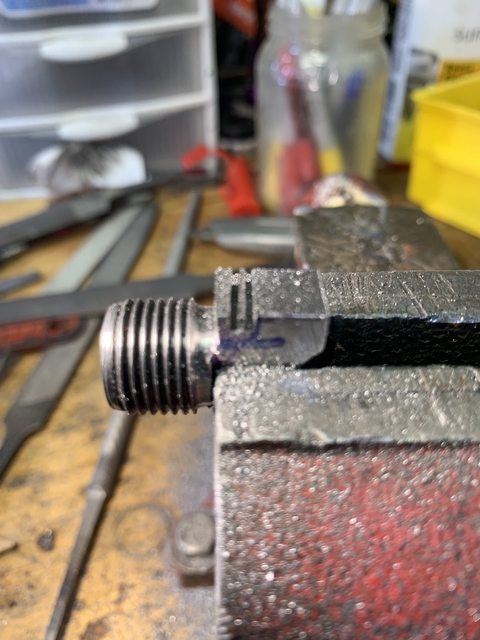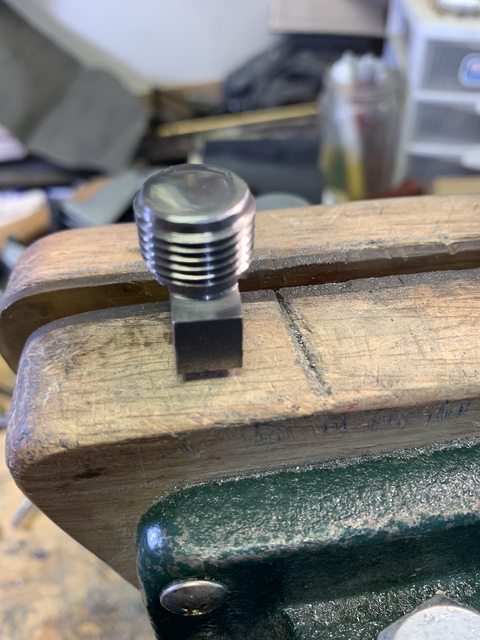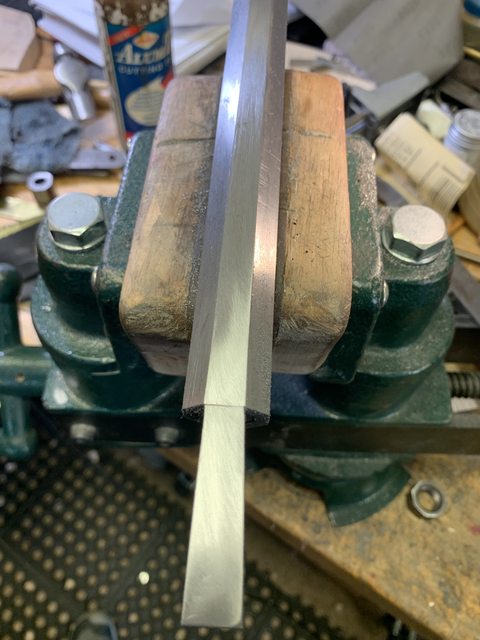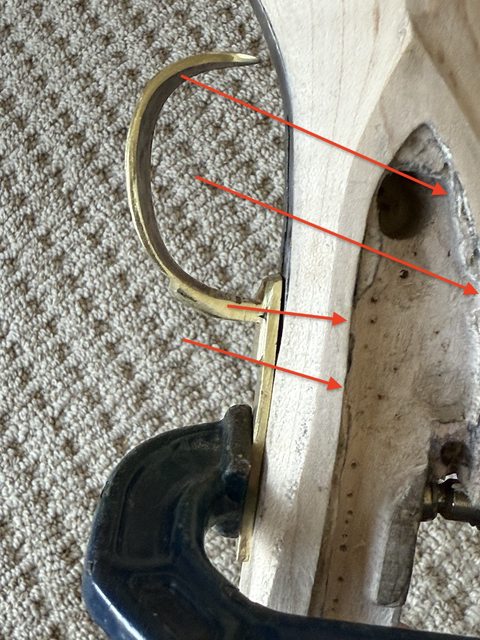Almost 40 years ago ( perhaps 1986) I bought a golden Age Arms Kit gun with a 42" .40 Green Mountain straight sided barrel and small Siler lock.
I abandoned the job after making a mistake but kept the kit. I picked it up recently and and am stumbling through it again. I don't have a bench or a vice yet so it's all being done in my lap.
I found this forum and decided to post progess to get feedback. Here goes. I'm not claiming that this is going to turn out to be a work of art.
I fitted the breech plug back in the day. Recently i dropped a .1mm shim washer, followed by a second shim to test my fit. It appears I'm a little over half a thou from making contact with the face of the thread shoulder. Rather than finding someone to turn a 5 thou off the barrel and re-fitting I decided to call it good. If I want to get anal I'll stone down a thicker shim washer some day and put it in there.
Decades ago, in my enthusiasm, I took a spoke shave to the precarved stock. It shows up as the lighter area on the first of the pics below. During the process of inletting the breech plug I realized I never should have done that. That's when I gave up.
About a month I go i got the idea to re-bend the tang. You can see the results in the two following pics. Not pretty, but functional.



Last week I finished the breech plug inlet and decided to work on the lock.
I used an RO sander to get the side panel flat and square with the top flat of the barrel. That's when the fun began.
in locating the touch hole liner I found that it's OD is just a couple thou smaller than the flat of the 13/16 barrel. That dictated a center drill on. the barrel flat. Next I located the touch hole center on the side panel and began messing with the lock position. Two problems popped up.
1.) The web on top of the ramrod hole wasn't thick enough to cover the OD of an 8-32 sideplate screw. I figured I could find a work around for that.
2.) If I did get the front side plate screw just under the bottom barrel flat that dictated a rotation of the lock plate that was going to either put the lock plate off the bottom of the side panel or cover up the touch hole and require skipping the touch hole liner and drilling a standard touch hole high in the barrel flat, angling it down to the powder chamber.
I decided to rotate the lock to place the sideplate screw UNDER the ramrod channel bringing the lockplate back onto the side panel as you can see in the pic below. We'll see how this works out. My concern is it's going to look goofy when done, especially on the side plate side, but I hope i can find some way to "hide" that.

I've inletted the bolster down to the point of full side panel contact by the lock plate. Surprisingly the inlet holds the bolster tightly with no movement. The lockplate outline can be seen in the picture below.

Now it's time to inlet the lock fully. The I'll get to find out if I laid it out properly and the pan aligns with the planned location of the touch hole. Man, the layout is TIGHT!
Knobs
I abandoned the job after making a mistake but kept the kit. I picked it up recently and and am stumbling through it again. I don't have a bench or a vice yet so it's all being done in my lap.
I found this forum and decided to post progess to get feedback. Here goes. I'm not claiming that this is going to turn out to be a work of art.
I fitted the breech plug back in the day. Recently i dropped a .1mm shim washer, followed by a second shim to test my fit. It appears I'm a little over half a thou from making contact with the face of the thread shoulder. Rather than finding someone to turn a 5 thou off the barrel and re-fitting I decided to call it good. If I want to get anal I'll stone down a thicker shim washer some day and put it in there.
Decades ago, in my enthusiasm, I took a spoke shave to the precarved stock. It shows up as the lighter area on the first of the pics below. During the process of inletting the breech plug I realized I never should have done that. That's when I gave up.
About a month I go i got the idea to re-bend the tang. You can see the results in the two following pics. Not pretty, but functional.



Last week I finished the breech plug inlet and decided to work on the lock.
I used an RO sander to get the side panel flat and square with the top flat of the barrel. That's when the fun began.
in locating the touch hole liner I found that it's OD is just a couple thou smaller than the flat of the 13/16 barrel. That dictated a center drill on. the barrel flat. Next I located the touch hole center on the side panel and began messing with the lock position. Two problems popped up.
1.) The web on top of the ramrod hole wasn't thick enough to cover the OD of an 8-32 sideplate screw. I figured I could find a work around for that.
2.) If I did get the front side plate screw just under the bottom barrel flat that dictated a rotation of the lock plate that was going to either put the lock plate off the bottom of the side panel or cover up the touch hole and require skipping the touch hole liner and drilling a standard touch hole high in the barrel flat, angling it down to the powder chamber.
I decided to rotate the lock to place the sideplate screw UNDER the ramrod channel bringing the lockplate back onto the side panel as you can see in the pic below. We'll see how this works out. My concern is it's going to look goofy when done, especially on the side plate side, but I hope i can find some way to "hide" that.

I've inletted the bolster down to the point of full side panel contact by the lock plate. Surprisingly the inlet holds the bolster tightly with no movement. The lockplate outline can be seen in the picture below.

Now it's time to inlet the lock fully. The I'll get to find out if I laid it out properly and the pan aligns with the planned location of the touch hole. Man, the layout is TIGHT!
Knobs












